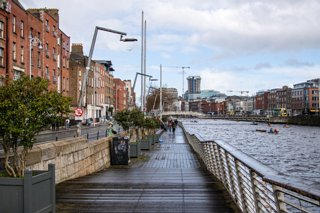GRATTAN BRIDGE
Grattan Bridge in Dublin
History
Essex Bridge (1676): Grattan Bridge's predecessor was Essex Bridge, the first bridge constructed at this location. Built by Sir Humphrey Jervis, it opened in 1676, connecting Capel Street's Dutch-style mansions to the south of the River Liffey.
Collapse and Reconstruction (1751-55): Essex Bridge was prone to flooding and partially collapsed in 1751. George Semple, a renowned architect, designed a new five-arched masonry bridge completed in 1755.
Widening and Renaming (1872-74): In the 1870s, the bridge was remodeled to accommodate wider roadways and footpaths. Designed by Parke Neville and Bindon Blood Stoney, cast-iron supports extended the bridge outward, creating space for pavements, ornate lamp standards, and wrought iron parapets. It reopened as Grattan Bridge in 1874, named after the Irish parliamentarian Henry Grattan.
20th Century Refurbishments: The bridge underwent further upgrades throughout the 20th century, with major refurbishment in 2002 to improve structural integrity and upgrade pedestrian walkways.
Features
Architectural Style: Grattan Bridge blends elements of its 18th-century origins with the Victorian-era additions. This includes the original masonry arches combined with the later cast-iron extensions.
Ornate Lamp Standards: One of the bridge's most distinctive features is the series of cast-iron lampposts that line the exterior. Some of these posts feature decorative mythical hippocampus figures (part horse, part fish).
River View: The bridge offers scenic views of the River Liffey, showcasing both the historic Dublin cityscape and its more modern developments.
Significance
Historical Landmark: Grattan Bridge is one of the oldest bridges spanning the Liffey, embodying the architectural changes Dublin has seen over centuries.
Central Location: Connecting Capel Street to Parliament Street and the southside, Grattan Bridge sits at a bustling point in Dublin's heart.
Symbol of Irish Independence: Its renaming honors Henry Grattan, a prominent politician who advocated for greater Irish legislative independence in the 18th century.
Visiting Grattan Bridge
Grattan Bridge is a busy artery in the heart of Dublin:
- Walk Across: Experience it as part of a stroll along the Liffey or while exploring central Dublin.
- Appreciate the Architecture: Take a moment to admire the lamp standards, ironwork, and blend of architectural styles.
- Nearby Landmarks: Combine your visit with exploring Capel Street, City Hall (just across the river), or Dublin Castle a short distance south.

GRATTAN BRIDGE
SELECT AN IMAGE TO VIEW SLIDESHOWS